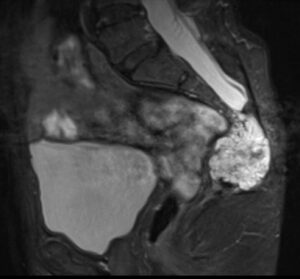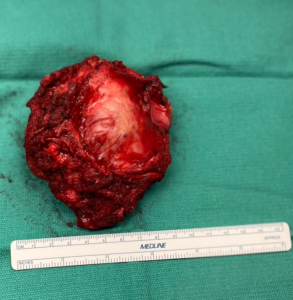Devinder describes her mother, Bhupinder, as fairly healthy and very active. But in September of 2022, Bhupinder started to notice numbness and tingling in her legs. She then developed frequent and intense cramps to her lower body. Her symptoms made it difficult to fall asleep and stay asleep, or sit for long periods of time.

When Bhupinder’s symptoms began interfering with her sleep and day to day activity level, Devinder became concerned for her mother, who was 72-years-old at the time. As a nursing supervisor, Devinder sees patients whose lives have been disrupted by various health conditions. So when Bhupinder noticed a bump had formed on her back, Devinder insisted that her mother go see her primary care doctor.
Bhupinder’s primary care provider ordered a CT scan which confirmed the presence of a tumor on the spine. She then referred Bhupinder to the multidisciplinary neuro-oncology clinic at UNC Health. Dr. Cheerag Upadhyaya, spine surgeon at UNC Health, first met with Bhupinder and explained that she had a sacral chordoma, a rare spine tumor. Dr. Upadhyaya explained that she may need to have the tumor surgically removed.
Chordoma is a malignant, slow-growing and locally aggressive tumor. It arises from remnants of the notochord and accounts for 1–4% of all primary bone tumors. Sacral chordomas are located in the sacrum, which is located at the base of the spine. Tumors in the sacrum are extremely rare, with fewer than 1,000 diagnosed each year. These tumors can be difficult to diagnosis and are often detected too late. A quick diagnosis and effective surgical resection are crucial for successful treatment.
Initially, Bhupinder was apprehensive about having surgery. “Dr. Upadhyaya was so nice and organized WebEx meetings for me and my siblings after hours to meet with him,” said Devinder. “He accommodated the whole family and we were able to make a decision.” Dr. Upadhyaya also discussed the patient’s case at a multi-disciplinary tumor conference to ensure that all treatment options were reviewed.

During the calls, Dr. Upadhyaya explained that sacral chordomas were not his area of expertise, and introduced Bhupinder and her family to Dr. Michael Galgano, director of spinal oncology and spinal deformity at UNC Health. “Both of them together along with family friends in medicine changed my mom’s mind,” said Devinder. “I remember Dr. Upadhyaya saying that my mom is 72 going on 68. Dr. Upadhyaya said ‘if you were my mother, I would recommend this’ and that reassured her.”
In February 2023, Bhupinder went in for surgery. Dr. Galgano and Dr. Upadhyaya together performed a curative “en bloc” resection to remove the tumor.
Bhupinder’s tumor came to just beneath the skin, which presented some challenges during surgery when the sacrum was exposed. “One of the key components of this particular surgery is staying out of the chordoma,” explained Dr. Galgano. “We want to remove it en bloc with negative margins, to increase the chances of an oncologic cure or prolonged disease-free interval. Every effort had to be made to stay away from the margins of the tumor, while still making every effort to remove it in one piece.”
Bhupinder was born with spina bifida occulta, which created an additional challenge for her surgical team. “We had to be very careful when exposing her sacrum so as to not enter the tumor, but also to avoid entering her spinal fluid space,” said Dr. Galgano.
The surgery lasted for six hours. In the late afternoon, both Dr. Upadhyaya and Dr. Galgano came out to update the family. They had successfully removed the entire tumor. Soon after, Devinder was allowed back to be with her mother before she was taken to her recovery room.
Initially, the family had been told that their mother would need to spend 3-4 weeks in the hospital after surgery. But Bhupinder spent only two weeks in the hospital before being cleared for discharge. “It was a very good experience,” said Bhupinder of her recovery and stay in the hospital. “Whole staff was awesome.”
Devinder, her father, and her sisters were also impressed with Bhupinder’s care and the attention she received daily from her doctors and care team. “Dr. Galgano came in twice a day and Dr. Upadhyaya came in a couple of times,” said Devinder. “Their extended staff and APPs and fellows came to check on her, too. She had pain, but it was well controlled with the medicine.”
When she was discharged, Bhupinder was able to ride comfortably to her daughter’s home in Durham. “The nurse helped get her in the car laying her on her side in the back seat,” said Devinder.
After discharge, Bhupinder completed a short course of outpatient physical therapy. She did not require radiation or chemotherapy since the entire tumor was removed in one piece, and her most recent MRI showed no recurrence of the chordoma.
Now that the tumor has been removed, Bhupinder no longer experiences numbness or leg cramps that keep her awake at night. She is also able to manage any pain by taking over-the-counter pain medications. “Follow-up care has been very good,” said Devinder. “Dr. Galgano is on top of it.”
When Devinder asked her mother if she would go through with the surgery again, her response was a definitive “yes.”